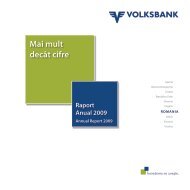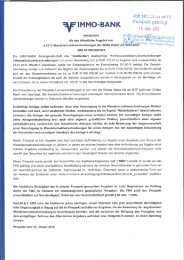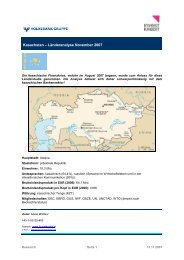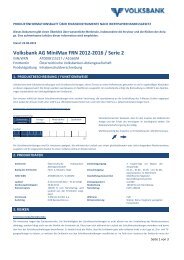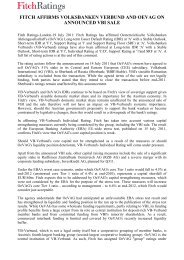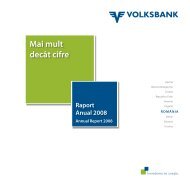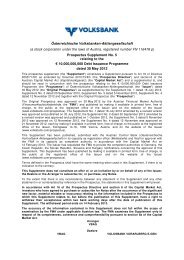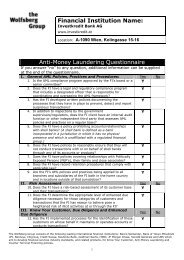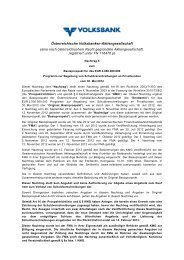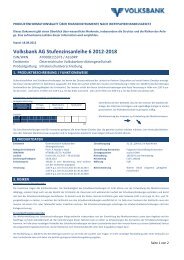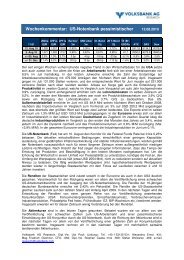I This document constitutes the base prospectus of ... - Volksbank AG
I This document constitutes the base prospectus of ... - Volksbank AG
I This document constitutes the base prospectus of ... - Volksbank AG
Create successful ePaper yourself
Turn your PDF publications into a flip-book with our unique Google optimized e-Paper software.
- Hedging Disruption means that <strong>the</strong> Issuer is in no position, upon application <strong>of</strong> economically reasonable<br />
efforts, (A) to conclude, continue or settle transactions and purchase, exchange, hold or sell assets respectively,<br />
which <strong>the</strong> Issuer deems necessary for <strong>the</strong> hedging <strong>of</strong> price risks related to <strong>the</strong> Underlying (or several<br />
<strong>the</strong>re<strong>of</strong>) with regard to its obligations under <strong>the</strong> respective Securities deemed necessary, or <strong>the</strong> Issuer (B) is<br />
in no position to realise, recover or forward <strong>the</strong> proceeds <strong>of</strong> <strong>the</strong> transactions and assets respectively; and<br />
- Increased Hedging Costs means that <strong>the</strong> Issuer has to pay a substantially higher amount (in comparison to<br />
<strong>the</strong> issue date) <strong>of</strong> taxes, charges, expenditures and fees (excluding brokerage fees) in order to (A) conclude,<br />
continue or settle transactions and purchase, exchange, hold or sell assets respectively, which <strong>the</strong> Issuer<br />
deems necessary for <strong>the</strong> hedging <strong>of</strong> price risks related to <strong>the</strong> Underlying (or several <strong>the</strong>re<strong>of</strong>) with regard to<br />
its obligations under <strong>the</strong> respective Securities deemed necessary, or <strong>the</strong> Issuer (B) is in no position to realise,<br />
recover or forward <strong>the</strong> proceeds <strong>of</strong> <strong>the</strong> transactions and assets respectively, under <strong>the</strong> condition that<br />
amounts which have only increased due to <strong>the</strong> fact that <strong>the</strong> creditworthiness <strong>of</strong> <strong>the</strong> Issuer has decreased are<br />
not regarded as Increased Hedging Costs.<br />
Should any <strong>of</strong> <strong>the</strong> above take place and <strong>the</strong> Issuer exercise its right to redeem <strong>the</strong> Securities early, <strong>the</strong><br />
yields received upon redemption may be lower than expected, and <strong>the</strong> redeemed face amount <strong>of</strong> Securities<br />
may be lower than <strong>the</strong> purchase price paid by <strong>the</strong> investor and part <strong>of</strong> <strong>the</strong> capital invested by <strong>the</strong> investor<br />
may be lost, so that <strong>the</strong> investor in such case would not receive <strong>the</strong> total amount <strong>of</strong> <strong>the</strong> capital invested. In<br />
addition, a future yield expected by <strong>the</strong> investor may be lost and investors that have received monies<br />
through an early redemption and choose to reinvest such monies may be able to do so only in securities<br />
with a lower yield than <strong>the</strong> redeemed Securities.<br />
Interest rate risk<br />
The interest rate risk is one <strong>of</strong> <strong>the</strong> central risks <strong>of</strong> interest-bearing instruments. The interest rate level on <strong>the</strong><br />
money and capital markets may fluctuate on a daily basis and cause <strong>the</strong> value <strong>of</strong> <strong>the</strong> Securities to change on<br />
a daily basis. The interest rate risk is a result <strong>of</strong> <strong>the</strong> uncertainty with respect to future changes <strong>of</strong> <strong>the</strong> market<br />
interest rate level. In particular, investors in Fixed Rate Notes are exposed to an interest rate risk that could<br />
result in a diminution in value if <strong>the</strong> market interest rate level increases. In general, <strong>the</strong> effects <strong>of</strong> this risk<br />
increase as <strong>the</strong> market interest rates increase. Conversely, a decreasing market interest rate level may result<br />
in an increase in <strong>the</strong> market value <strong>of</strong> <strong>the</strong> Securities.<br />
The market interest rate level is strongly affected by public budget policy, <strong>the</strong> policies <strong>of</strong> <strong>the</strong> central bank,<br />
<strong>the</strong> overall economic development and inflation rates, as well as by foreign interest rate levels and exchange<br />
rate expectations. However, <strong>the</strong> importance <strong>of</strong> individual factors cannot be directly quantified and<br />
may change over time.<br />
The interest rate risk may cause price fluctuations during <strong>the</strong> term <strong>of</strong> any Security. The longer <strong>the</strong> remaining<br />
term until maturity <strong>of</strong> <strong>the</strong> Securities and <strong>the</strong> lower <strong>the</strong>ir rates <strong>of</strong> interest, <strong>the</strong> greater <strong>the</strong> price fluctuations.<br />
A materialisation <strong>of</strong> <strong>the</strong> interest rate risk may result in delay in, or inability to make scheduled interest<br />
payments.<br />
Credit risk<br />
Investors are subject to <strong>the</strong> risk <strong>of</strong> a partial or total failure <strong>of</strong> <strong>the</strong> Issuer to make interest and/or redemption<br />
payments that <strong>the</strong> Issuer is obliged to make under <strong>the</strong> Securities.<br />
A materialisation <strong>of</strong> <strong>the</strong> credit risk may result in partial or total failure <strong>of</strong> <strong>the</strong> Issuer to make interest and/or<br />
redemption payments.<br />
Credit spread risk<br />
A credit spread is <strong>the</strong> margin payable by an Issuer to <strong>the</strong> holder <strong>of</strong> a Security as a premium for <strong>the</strong> assumed<br />
credit risk. Credit spreads are <strong>of</strong>fered and sold as premiums on current risk-free interest rates or as discounts<br />
on <strong>the</strong> price.<br />
41



